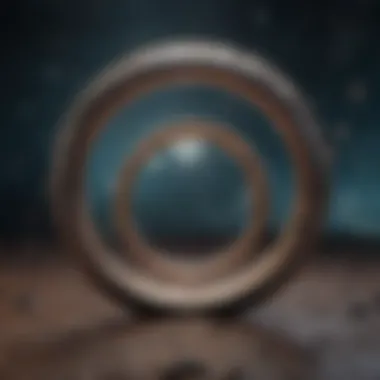Eccentric Rings: A Comprehensive Exploration


Research Overview
Eccentric rings represent a unique intersection of various scientific fields. These structures, distinctive in their non-concentric nature, offer insights into numerous phenomena. They can be found in different disciplines, from astronomy to materials science. Understanding them requires a blend of theoretical and practical perspectives, leading to rich discussions in both educational and research environments.
Summary of Key Findings
Eccentric rings carry significant implications. First, they aid in comprehending celestial bodies. For instance, observations of Saturn’s rings indicate the presence of eccentricity, suggesting complex gravitational interactions at play. Furthermore, these rings manifest in materials science, where variations in structure can influence properties like strength and flexibility.
Eccentric rings hold a notable position in the scientific community, encouraging exploration into their formation and function.
Background and Context
The study of eccentric rings dates back to early astronomical observations. Significant advancements have resulted in discoveries that link these rings to planets and moons. In materials science, research has expanded significantly over the past few decades, revealing the potential utility of eccentric structures in engineering applications.
To grasp the importance of eccentric rings, a multidisciplinary approach is vital. By merging disciplines, researchers can better understand the mechanics behind these structures and how they influence broader scientific concepts.
Methodology
Research into eccentric rings requires thorough processing and analysis of various data types. The methodology often involves both experimental and theoretical elements.
Experimental Design
Creating models to simulate eccentric rings involves advanced technology. Computer simulations often play a role in predicting behavior under different conditions. Additionally, experimental setups can include physical models to observe real-time dynamics in a controlled environment. Collaboration between fields like astrophysics, engineering, and software development proves beneficial in refining these designs.
Data Collection Techniques
Data collection plays a crucial role in understanding eccentric rings. Astronomical observations, such as those conducted by the Hubble Space Telescope, provide valuable insights. Satellite imaging and spectrometry are also employed to gather detailed information on these structures. In materials science, techniques like x-ray diffraction and scanning electron microscopy allow researchers to analyze the microscopic features of eccentric structures, unveiling their properties and behaviors.
Through these methodologies, the quest for knowledge concerning eccentric rings continues to unfold. Each layer of data adds depth to the understanding, highlighting the ongoing need for research and innovation in this field.
Prelims to Eccentric Rings
Eccentric rings present a unique area of study pertinent to various fields, notably astronomy and materials science. The exploration of these structures opens doors to understanding complex physical phenomena. They are not merely shapes that exhibit irregularities; they carry significant implications for both theoretical and practical applications. In this article, we aim to dissect their characteristics, origins, and implications.
Understanding eccentric rings is essential for grasping broader concepts in celestial mechanics. Their formations can affect the orbits of celestial bodies. Also, these rings serve as platforms for investigating material properties that enhance engineering designs and innovations. Thus, the topic intertwines science and engineering, providing benefits that are relevant in today's technological advancements.
Definition and Characteristics
Eccentric rings, as the name suggests, differ from conventional circular rings due to their non-uniformity. These rings exhibit a distinctive geometry where their center does not coincide with the geometrical center of their mass distribution. Such characteristics lead to nonlinear dynamics that can be observed across various mediums, from cosmic structures to engineered materials.
The defining features include:
- Geometry: Eccentric rings may take on various forms, often leading to intriguing oscillatory behaviors.
- Dynamic Interaction: Their behavior under external forces can result in unique frictional properties, affecting how they interact with surrounding materials.
- Material Diversity: They can be constructed from various materials, including metals, polymers, and composites, each influencing their physical properties.
Understanding these characteristics allows researchers to model and predict behaviors associated with eccentric rings.
Historical Context and Development
The study of eccentric rings has evolved over centuries. The early observations of rings around planets, notably Saturn, laid the groundwork for modern physics. Ancient astronomers, relying on rudimentary telescopes, first noted the peculiar shapes of these ring systems. However, it wasn't until advancements in technology that a deeper understanding of their nature began.
In the late 20th century, the launch of spacecraft like Voyager provided vital data about the composition and dynamics of extraterrestrial rings. This marked a significant shift in how scientists approached the study of these structures. Concurrently, in materials science, the conceptualization of eccentric rings transitioned from theoretical frameworks to practical applications, especially within the context of nanotechnology.
Today, the analysis of eccentric rings not only spans astronomical phenomena but also informs engineering practices. Emerging research continuously updates our understanding, blending historical insights with cutting-edge discoveries. This evolving field illustrates the importance of sustained inquiry into eccentric rings, shedding light on both past and contemporary scientific advancements.
The Science Behind Eccentric Rings
Understanding the science behind eccentric rings is crucial for grasping their role across various fields. These rings do not only exist in astronomy but also find their application in materials science and engineering. The concepts related to their formation and properties offer insights into their significance. The mechanics involved, from physical processes to their mathematical descriptions, provide a strong foundation for study and innovation.
Formation Mechanisms


Physical Processes
Physical processes refer to the mechanisms through which eccentric rings develop and maintain their structure. This aspect involves various phenomena such as gravitational interactions, particle collisions, and the influence of external forces. The importance of this topic lies in its contribution to understanding how different conditions lead to the formation of these rings.
A key characteristic of physical processes is the qualitative nature of their impact. For instance, gravitational forces play a significant role in defining the unique characteristics of the rings. This makes it a beneficial focus for the article, as understanding these forces can lead to insights about their stability and evolution.
The unique feature of physical processes includes their adaptability in various environments. They can be affected by different celestial mechanics and environmental conditions, leading to diverse outcomes. However, the complexity of these interactions may also be seen as a disadvantage. The unpredictable nature of some processes can make it difficult to draw concrete conclusions.
Mathematical Models
Mathematical models serve as essential tools to represent the behavior of eccentric rings in a quantified manner. These models can simulate processes such as the formation, evolution, and stability of these structures. The significance of this topic is its ability to provide predictive capabilities, allowing researchers to understand potential scenarios and behaviors of the rings.
A fundamental characteristic of mathematical models is their precision. They can offer specific predictions about how certain variables will influence the formation and dynamics of the rings. This makes them a valuable part of the research presented in this article, as their clarity and accuracy can simplify complex theories.
One unique aspect of mathematical models is their versatility. They can be adapted and applied across different disciplines, from astronomy to engineering. Nevertheless, a drawback is that they often rely heavily on assumptions that, if inaccurate, can lead to misleading conclusions. Thus, careful consideration is required when interpreting these models.
Physical Properties
Material Composition
Material composition encompasses the specific elements and compounds that make up eccentric rings. This discussion is significant as it affects the mechanical and physical properties of the rings. The composition can determine factors such as density, resilience, and thermal behavior, impacting their overall functionality.
A key characteristic of material composition is its diversity. Eccentric rings can be made from a range of materials, from ice particles in Saturn's rings to rocky debris in the asteroid belt. This variety makes it a beneficial theme for the article since it opens discussions on different behaviors based on elemental differences.
The unique possibility of studying different compositions presents advantages. Researchers can explore how varying materials respond under different stresses. Yet, there can also be disadvantages, such as difficulties in obtaining accurate samples, especially from distant celestial bodies.
Behavior Under Stress
Understanding behavior under stress is vital for analyzing how eccentric rings respond to forces acting upon them. Various stressors, including gravitational pull and collision force, influence the stability and arrangement of particles in the rings. Highlighting this topic is crucial for recognizing the dynamics at play.
The key characteristic of behavior under stress is its multidimensionality. Stress can manifest in various ways, such as deformation or fragmentation of the rings. This aspect makes it a popular choice for the article, as it allows readers to grasp the complexities and potential changes in structure over time.
A unique aspect of behavior under stress is that it can reveal weaknesses in the ring system. Studying these vulnerabilities can provide insights into failure points. On the downside, predicting behavior can be challenging due to the multitude of influencing factors, leading to complex simulations and experiments. It is necessary to approach the interpretations meticulously.
Eccentric Rings in Astronomy
Eccentric rings play a crucial role in the study of astronomy. Their existence not only enhances our understanding of planetary systems but also offers insights into the fundamental laws of celestial mechanics. The dynamics involved in these rings help scientists decipher the formation and evolution of planets and the unique properties of their surroundings. By examining the primary components of eccentric rings found in astronomical settings, we can elucidate both their influence on celestial bodies and their behavior under various cosmic forces.
Planetary Ring Systems
Saturn and its Rings
Saturn is perhaps the most iconic example when discussing eccentric rings. Its rings are made up primarily of ice particles, with some rocky debris. This composition allows for detailed observation through telescopes, making Saturn's rings a popular choice for studies focusing on planetary rings. The phenomenon of the ring system's eccentricity enhances its visual grandeur and establishes a point of interest in astrophysics.
A key characteristic of Saturn’s rings is their stunning structure. They exhibit several distinct subdivisions, including the A, B, and C rings, each with unique features such as gaps and waves. These subdivisions are detectable due to varying particle sizes and densities. Such diversity provides valuable data regarding the conditions present during the rings' formation.
A unique feature of Saturn's rings lies in their dynamic motion. The gravitational influence of Saturn’s moons, especially Mimas and Enceladus, creates resonance patterns that maintain the structure of the rings. This interaction presents advantages in understanding gravitational mechanics in a practical context, although it also complicates the dynamics in the evolution of the ring's shape over time.
Jupiter's Lesser-Known Rings
Jupiter’s rings, while often overshadowed by Saturn’s, present a different avenue of interest. The characteristics of Jupiter’s rings are decidedly less grand, primarily composed of a thin band of dust and small particles. This lack of bulk leads to challenges in their observation, making them a lesser-known, yet fascinating part of ring studies.
The primary elements constituting these rings arise from moonlet collisions and cosmic dust, which continuously replenish the rings. This aspect highlights the dynamic processes that govern the maintenance and evolution of rings in less massive planetary systems. An interesting factor related to Jupiter's rings is their invisible nature to navigational instruments, relying more on indirect observation methods than direct imaging.
In terms of unique features, the rings of Jupiter are extremely narrow and relatively faint. They lack the vibrancy found in Saturn's systems. However, the minimalist complexity of Jupiter’s rings offers scientists a different lens through which to study the mechanics of ring formation and the influences of surrounding celestial objects.
Celestial Mechanics and Dynamics


Orbital Resonances
Orbital resonances are critical to understanding the behavior of eccentric rings. This phenomenon occurs when two orbiting bodies exert regular, periodic gravitational influence on one another, usually due to their orbital periods being related by a ratio of small integers. These resonances can significantly impact the stability and longevity of planetary rings.
A defining characteristic of orbital resonances in eccentric rings is their ability to maintain the shape and structure of the rings over long periods. They contribute to the creation of gaps within rings, similar to the Cassini Division found in Saturn’s system. This intricate behavior provides unique insights into the physics of orbital mechanics, making it a valuable subject in this analysis.
The unique aspect of orbital resonances is their role in preventing the merging of ring particles into larger bodies. This encouragement to preserve smaller particles ensures the rings remain vibrant and complex, offering advantages when studying planetary formation theories.
Stability Criteria
Stability criteria are another essential factor that influences the dynamics of eccentric rings. These criteria define the conditions under which a celestial body remains in equilibrium amidst gravitational forces. Understanding stability helps in assessing why certain rings are stable while others may collapse or disperse.
A significant characteristic of stability criteria involves the balance between gravitational forces and tidal interactions from nearby moons. This balance plays a critical role in maintaining the ring's structure. The reliance on these criteria adds depth to the study of ring dynamics, highlighting the delicate interplay of forces at work in such environments.
While the unique feature of stability criteria may seem complex, its implications for predicting the longevity and evolution of rings makes it a compelling aspect of astronomical studies. The ability to describe conditions that sustain ring structures greatly enhances the study of planetary systems as a whole.
Applications of Eccentric Rings in Materials Science
The relevance of eccentric rings in materials science cannot be overstated. These rings are more than just geometrical constructs; they have real-world implications in various engineering applications. With unique properties, they help in solving complex issues. Understanding their applications assists researchers, engineers, and designers in harnessing their benefits effectively.
Engineering Innovations
Structural Applications
Structural applications of eccentric rings are noteworthy in various fields such as civil engineering and mechanical design. Their unique geometry often leads to improved load distribution. This characteristic makes them ideal for creating robust structures. The efficiency they bring to load-bearing capacity simplifies many design challenges.
One significant benefit of using eccentric rings in structures is their ability to reduce stress concentrations. This reduces the risk of material failure under load. They also offer advantages in manufacturing processes, as they can be designed to fit various specifications. The unique feature of these rings is their adaptability; they can be produced in different sizes and materials for specific applications. However, one downside may be the complexity in analysis and design due to their non-uniform shapes.
Nanotechnology
Nanotechnology also finds significant utility with eccentric rings. At the nano scale, these rings exhibit unique mechanical properties. This allows for innovations in material science that were not previously attainable. The key characteristic of utilizing eccentric rings in nanotechnology is the enhancement of material properties at very small scales, leading to smarter materials.
The unique feature is their ability to manipulate surface energy at the nanoscale. This characteristic opens new avenues for applications such as drug delivery systems and improved chemical sensors. However, challenges exist, including the precise control of their formation and integration into larger systems. Despite these challenges, the potential benefits of using eccentric rings in nanotechnology greatly outweigh the drawbacks.
Impact on Mechanical Properties
Eccentric rings have a profound impact on the mechanical properties of materials. Their design influences the overall performance while enhancing key characteristics.
Enhancing Durability
Enhancing durability is one of the primary benefits of incorporating eccentric rings into materials. Their design allows for improved resistance to wear and tear. This can be extremely beneficial in sectors like aerospace and automotive, where reliability and long service life are critical.
The distinctive architecture of eccentric rings makes them effective in distributing stress evenly throughout a material. This reduces the risk of localized failures, a common concern in traditional designs. Using these rings, engineers can create components that endure harsher conditions with extended lifespans. However, the need for specialized materials and production methods could increase costs.
Reducing Weight
Reducing weight is another important application. The structural efficiency offered by eccentric rings supports lightweight designs without sacrificing strength. This characteristic is especially crucial in aerospace applications where every gram matters.
The unique feature of using eccentric rings to minimize weight without compromising structural integrity allows for innovations that lead to energy savings and enhanced fuel efficiency. One disadvantage may be the complexity involved in their integration, as redesigning existing systems can be a resource-intensive process.
Overall, the applications of eccentric rings in materials science demonstrate their versatility and innovative potential that can lead to advancements in various industries.
Cultural and Artistic Perspectives
Cultural and artistic perspectives on eccentric rings offer an important lens through which these structures can be appreciated beyond their scientific significance. In art, eccentric rings become symbols of complexity, beauty, and the infinite. The interplay between their geometric forms and our interpretations can provide insights into human experience and cultural history. Understanding these perspectives also highlights the emotional and intellectual connections we have with shapes and structures in our environment.
Eccentric Rings in Art


Symbolism and Interpretation
Symbolism inherent in eccentric rings allows artists to convey deep meanings and provoke thought. These shapes can represent cycles, change, or the passage of time. Their visual rhythm captures a unique essence that resonates with the observer. Eccentric rings become a beneficial choice for artists since they evoke curiosity. The dynamic nature of these forms can reflect the complexity of existence. Their interpretation encourages viewers to explore personal and societal themes. This engagement enriches our understanding of both the artwork and the artist's message.
A unique feature of this symbolism is its adaptability. Eccentric rings can be fitted into various cultural narratives and artistic movements, allowing for diverse interpretations. However, the potential downside lies in the possibility of oversimplification. Without a nuanced approach, one may miss out on the multifaceted meanings that these shapes can embody in different contexts.
Famous Artistic Representations
Famous artistic representations of eccentric rings reveal their implications within visual culture. Pieces by artists such as Gustav Klimt and Wassily Kandinsky utilize circular forms and contrasting shapes to express emotion and dynamism. Such representations contribute significantly to understanding how eccentric rings can influence perception and aesthetic experience. These works exemplify how blending geometric precision with organic expression can yield powerful artistic statements. They attract audiences and stimulate dialogue about form and emotion.
What stands out in famous representations is their ability to transcend the formal characteristics of eccentric rings. They communicate deeper connections to themes like harmony, chaos, and the cyclical nature of life. This universal appeal makes them relevant choices in contemporary discussions about art and abstraction.
However, one must also consider the challenges in interpreting these artworks. Different backgrounds and experiences can lead to varied understandings, sometimes clashing with the artist's intentions. Recognizing this complexity is crucial for a comprehensive appreciation of eccentric rings in art.
The Role of Eccentric Rings in Literature
Cultural References
Cultural references to eccentric rings in literature sketch a vast landscape of significance. Authors may use these images to symbolize interconnectedness, chaos, or life's complexities. They serve as metaphors for human experience. This characteristic proves effective in narrative building, enabling deeper thematic explorations. Such references enrich interpretations and stimulate critical discussions around stories and characters.
Cultural references enhance a text's engagement level. They resonate with readers on multiple levels, allowing for familiarity combined with intellectual curiosity. A unique aspect of these references is their elasticity. They can fit seamlessly into various literary genres, from poetry to science fiction. However, these references may sometimes be missed by readers not well-versed in the symbolism.
Literary Analysis
Literary analysis of eccentric rings sheds light on their multifaceted representations within texts. These structures can act as motifs that underscore central themes, enhancing the narrative's coherence. The examination unveils layers of meaning that may resonate with existential questions or societal challenges. This analytical approach serves as a vital tool for comprehending the narrative's depth.
One key characteristic of literary analysis is its focus on context. The surrounding text and the author's background play essential roles in understanding the implications of eccentric rings. Their unique feature lies in the capacity to unlock diverse interpretations based on literary schools of thought or cultural backgrounds. While enriching, this multiplicity can complicate straightforward readings and lead to misinterpretation if not approached thoughtfully.
Eccentric rings, in all their forms, challenge us to sustain an dialogue. Whether seen in art or literature, they urge reflection on their implications within broader cultural narratives. Understanding these perspectives lays a foundation for exploring the future possibilities surrounding these extraordinary shapes.
"Art is the most beautiful of all lies"—Pierre-Auguste Renoir.
Eccentric rings remind us of this essence by blending reality with creative imagination.
Future Research Frontiers
Eccentric rings present an area ripe for future research, with potential insights across multiple scientific disciplines. Understanding the dynamics and characteristics of these structures can yield significant advancements in fields such as materials science, astronomy, and engineering. The exploration of future research directions is essential, as it opens pathways to new discoveries that can enhance both theoretical understanding and practical applications.
Potential Discoveries
Interdisciplinary Approaches
Interdisciplinary Approaches involve collaboration between various fields to address complex problems. This method is particularly valuable in studying eccentric rings, as it combines knowledge from physics, engineering, and material science. The key characteristic of interdisciplinary approaches is their ability to synthesize diverse perspectives, leading to innovative solutions. For instance, combining insights from engineering and astronomy could reveal new applications of eccentric rings in technology.
However, there are challenges to consider. While collaboration enhances creativity, it can also complicate communication across different areas of expertise. Researchers must be diligent in bridging gaps and ensuring that findings are understood clearly. Overall, interdisciplinary approaches facilitate exploration of eccentric rings from multiple angles, yielding rich and diverse insights.
Technological Advances
Technological Advances significantly impact the study of eccentric rings, offering new tools and methods for analysis. Recent innovations in simulation software and imaging technology enable researchers to observe these structures with greater detail and accuracy. A prominent characteristic of these advances is their capacity to process large datasets swiftly and efficiently. Such capabilities prove beneficial for conducting experiments and validating scientific theories surrounding eccentric rings.
Yet, dependence on technology raises concerns about accessibility. Not all researchers may have the resources or knowledge to use these technologies effectively. This limitation could create disparities in research outcomes. Nonetheless, the unique feature of technological advances is that they often lead to new questions and hypotheses, driving the field of study forward.
Closing Remarks
Significance of Continued Study
The Significance of Continued Study into eccentric rings cannot be overstated. This ongoing exploration not only enhances our understanding of fundamental principles but also has practical implications that extend into various scientific disciplines. A defining characteristic of continued study is its potential for generating breakthroughs that can transform existing theories and applications. The consistent examination of new information will reveal trends and patterns that may not be immediately apparent.
However, it requires sustained funding and scholarly interest to maintain momentum. Engaging with this subject is a beneficial choice, as it encourages holistic thinking around scientific problems and fosters innovation in related fields. Continued study acts as a catalyst for further curiosity and inquiry.
Encouragement for Exploration
Encouragement for Exploration serves a vital role in inspiring future researchers and scholars. As new methodologies evolve, there is an increased need for the academic community to embrace unconventional ideas. A key characteristic of encouraging exploration is its ability to instill a culture of inquiry, motivating individuals to develop original perspectives on eccentric rings.
However, the challenge lies in balancing encouragement with the realities of rigorous scientific standards. Supporting bold ideas while ensuring robust evaluations is a complex task. Ultimately, the unique feature of encouraging exploration promotes a dynamic integration of innovation into academic standards, reinforcing the importance of flexibility in the pursuit of knowledge.







